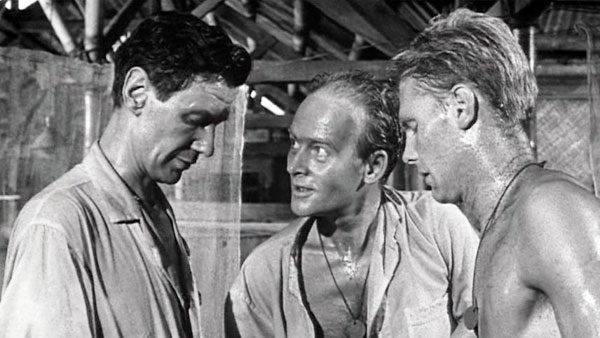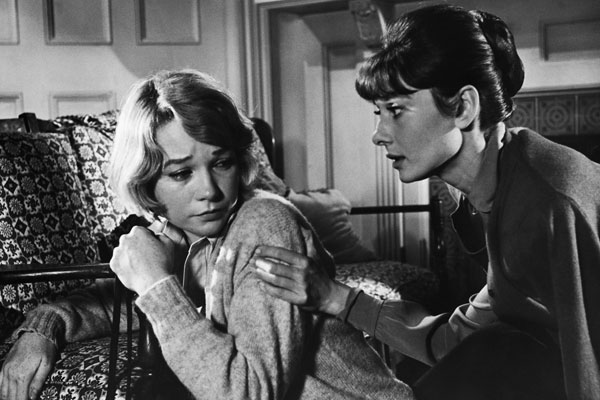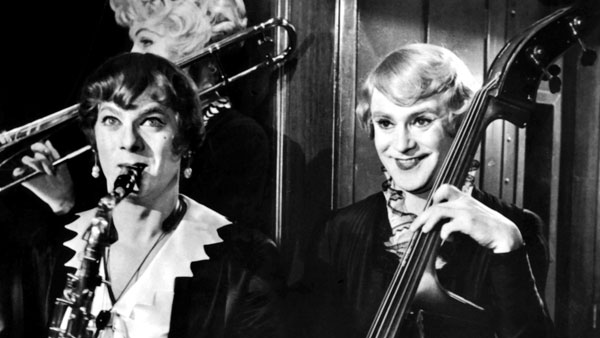Homosexual Themes in Cinema
part 1
by Lee Atwell
Tangents Vol. 1 No. 6
March 1966
Originally printed in the March 1966 issue of Tangents, pp. 4–10
Part 1: The American Film
During the last decade, even the most casual moviegoer has been bombarded with publicity and incantations about the new boldness and adult daring of American films. Hollywood, the superficial upholder of traditional American ethics, has suddenly become shockingly liberal. Unfortunately, the kind of boldness displayed by the commercial filmmaker has little to do with honesty or integrity and even less with a personal or artistic point of view toward material that might be categorized as taboo.
The ingrained social and moral prejudices of American culture and its social ramparts against any deviation from a mythical norm in the area of adult sexual relations is presumably giving way to a more healthy and liberal observation of basic human instincts. We are constantly reminded of this in contemporary drama and literature, in Beckett, Miller, and Genet. The impact of this emancipation upon Hollywood has been fairly predictable: more bedroom scenes, torrid rapes, adultery, inter-racial conflicts, abortion etc., all strung together in the most unlikely and tasteless fashion. But defiance of the Production Code and additional “sex interest” does not equal sincerity in a still rigidly anti-sexual culture. The obsession with sex has yet to be refined as an integral part of the individual’s life.

Since the cinema depends upon the public for its survival, it may be assumed that the interests and morality depicted must appeal primarily to the average man. Consequently, it reflects our essentially contradictory and false public morality. Any deviation from this system of values is viewed with derision or as a manifestation of decadence and evil in the private moral judgments of certain persons.
The topic of homosexuality has always been handled with kid gloves by Hollywood film makers. The increasing appearance of explicit homosexual themes in films such as Suddenly, Last Summer and The Children’s Hour are indications that at least some film makers recognize this fact of life. Recognition does not however provide acceptance or genuine understanding of the homosexual as an individual human being, with existential problems like those of all men. His deviant behavior is emphasized rather as a moral issue, subtly submerged in the thematic structure of a film, and remains, “the love that dares not speak its name.”
The theme of male friendships and relationships is not new to the American film. For years it has existed on a purely Platonic level. The heroics of Clark Gable and Spencer Tracy, of Gary Cooper, James Cagney and Humphrey Bogart glorify the male fraternity over male-female relationships. The intensity of male friendships with strong emotional ties are today poignantly displayed in Delbert Mann’s The Outsider (Tony Curtis and James Franciscus) and Ralph Nelson’s Soldier in the Rain (Steve McQueen and Jackie Gleason). Both films, notably The Outsider, reveal the potential problem of male relationships In the armed services. In Bryan Forbes’ King Rat, the problem Is raised in a Japanese POW camp where King (George Segal), an American opportunist, takes a liking to an English boy (James Fox). When King goes out of his way to comfort the boy and later saves his life, the scenes are treated with the affection and sensitivity of heterosexual love scenes.
Allusions to homosexuality appear in latent forms in American films even prior to the new liberalism, although they are always disguised and sublimated in a joking manner. The female impersonator has always been an object of cinematic interest from Chaplin and Laurel and Hardy to Cary Grant in I Was a Male War Bride and reaches its maddest culmination in Billy Wilder’s Some Like It Hot where Jack Lemmon’s masquerading leads him to the conviction that he really is a woman. Drag leads Bing Crosby to hilarious complications in High Time and Rock Hudson goes out of his way to prove his disinterest in females in A Very Special Favor. The burlesque of homosexual humor is evidenced in the tradition of effeminate butlers and valets, and more recently in the arch camp villains of the Vincent Price—Peter Lorre variety.

In many of Alfred Hitchcock’s films there are strong homosexual overtones. In Strangers on a Train, the initial meeting between the psychopathic killer Bruno (Robert Walker) and Guy (Farley Granger) is handled with a nervous tension that suggests a public solicitation. Hitchcock uses this kind of psychological device often to suggest and stimulate the unconscious associations of the viewer. In Rope, a subtle variation of the Leopold—Loeb situation, it is strongly suggested that John Dall and Farley Granger, the youthful Nietzschean-inspired murderers are linked by a homosexual bond. But Hitchcock, a master in depicting extremes in abnormal behavior (see Norman Bates in Psycho) rarely passes beyond the level of allusion, and we should expect nothing more perhaps in this particular genre.
The rise of television as an instrument of mass entertainment in the fifties turned the Hollywood producer increasingly to the “pre-sold” stageplay and novel adaptation. Regardless of it suitability for the film medium, a major success on Broadway or best-selling novel was assured a duplication of sorts by Hollywood. Two of the plays, which dealt in some degree with homosexuality were Tea and Sympathy and Cat on a Hot Tin Roof.
Robert Anderson’s Tea and Sympathy is a sensitive study of a young man’s struggle to achieve his emotional and sexual maturity in a relationship with an older woman. Basic to Tom’s story is the identification with an accepted male heterosexual role. In the play version Tom has been seen by his college mates nude bathing with a rumored homosexual instructor, and is henceforth branded as a “sissy.” To make matters worse he is taking a female role in the school play. Although innocent enough, Tom begins to have serious doubts about his manhood and consciously tries to avoid any traits that might jeopardize his integrity. Laura, the wife of one of Tom’s professors, takes him under her wing and convinces Tom that his fears of inadequacy can only be tempered by genuine love and respect.
In the film version, though the same cast was employed, Tom’s confusion of sex roles is defined, but all references to homosexuality are deleted. The emphasis is shifted toward the Tom—Laura relationship, and the important scene in which Laura reveals her husband’s early “tendencies,” is discreetly avoided.
In Cat On a Hot Tin Roof, Tennessee Williams’ favorite game of homosexuality as a repressed skeleton in the family closet is demonstrated. Brick (Paul Newman in the Richard Brooks film version) is Big Daddy’s favorite son and football hero who is rendered impotent by a drunken hurdle chase after the death of his closest friend. In the play version, Brick’s remorse over the loss is the bone of contention between Brick and the family, particularly Maggie, his frustrated cat-mate. In the film, all these conflicts are suggested but without an intimation of the nature of Brick’s former friendship. The pay-off scene in the stage play, where Big Daddy confronts Brick with the accusation that they were queer, which Brick too adamantly denies, is exorcised by the screen writer, and one of the motivating themes of the play is undercut.
Meyer Levin’s Compulsion was brilliantly brought to the screen with superb portrayals by Bradford Dillman and Dean Stockwell, along with Orson Welles. In a more intimate and revealing study of the Leopold and Loeb case, the film makers do not hesitate to be explicit about the strong homosexual bond between these two boys. And there is little question in the most innocent viewer’s mind when Dillman says to Stockwell in a jealous rage, “You mean you’re going to ditch me for some girl?”

Homosexuality emerges as a false accusation in Sidney Lumet’s version of Arthur Miller’s A View from the Bridge. Eddie Carbone (Raf Valone) who is unconsciously in love with his wife’s adolescent niece takes revenge on an immigrant boy who has made love to her, by playing up and kissing him before her. This is probably the first time in an American movie two men have been seen in an erotic embrace. Pauline Kael aptly notes: “After all these years of taboos, we finally get two men kissing on the screen and neither of them is supposed to be enjoying it. You’d think there were no homosexual in America, only heterosexuals falsely accused.”
Among the spate of Hollywood epic productions, there is perhaps only one that in passing acknowledges the frequent occurrence and acceptance of homosexual feelings in the ancient worlds of Greece and Rome. Dalton Trumbo was forced to eliminate characters and numerous situations in Howard Fast’s novel Spartacus in his screenplay. However, there was a scene, cut after the first showings of the film, between Roman general Laurence Olivier and his slave, Tony Curtis. After Curtis has finished assisting Olivier in his bath, the question is put to him, “Do you prefer oysters or snails? I take both” as the older man places his hands on the boy’s shoulders…. This advance sends the slave off to join Spartacus’ revolt. Toward the end of the film, the boy is mortally wounded protecting Spartacus (Kirk Douglas) and his leader grasps him to his breast, declaring his love for him in a moving and unaffected moment. But this sort of character revelation can only suggest a sentiment defines by a remote cultural environment, otherwise our sexually repressed yet obsessed consciences might squeamishly rebel.
The conscious repression of homosexuality is one of the central themes in Williams’ Suddenly Last Summer, that poem devoted to the memory of one Sebastian Venable. In the screen version, written by Gore Vidal and directed by Joseph Mankiewicz, there is ample evidence as to the nature of Katherine’s “evil babblings,” of Sebastian’s use of Violet and Katherine to attract young men on summer excursions. This is unmistakably clear in the flashback where we witness Katherine’s tortured remembrance of the traumatic death of Sebastian that previous summer, in some of the most evocative imagery ever seen in an American movie. It is significant to note that Sebastian’s face is never seen; he is always obscured, an enigmatic faceless ghost of a man. While this effect can be justified artistically, it might also be seen as an unconscious evasion on the part of filmmakers of confronting the real Sebastian.
The tragic realization of unconscious homosexual feelings is elaborated in William Wyler’s The Children’s Hour. Lillian Hellman’s play is a harsh condemnation of bourgeois Puritan ethics and social codes that threaten the life and happiness of the individual. Wyler has tried to maintain this point of view while centering his attention on the two schoolteachers who are ostracized as a result of a pupil’s malicious gossip, which, in fact, contains a grain of truth. But what is so disconcerting about The Children s Hour is the awful stifling presence of guilt in the air. We are made so pointedly aware of Shirley MacLaine’s lesbian tendencies that when she finally breaks down and confesses “the awful truth,” it is just embarrassing, and all we can say is “Oh, the poor girl.” And the hetero- sexual audience can settle back comfortably after her inevitable suicide when the straight girl gets the boy. Still, in the concluding funeral scene, we are reminded that love is a positive and stronger force, while pity and guilt are ultimately negative and self-destructive feelings.
Deviation on the political scene is broached in Franklin Schoffner’s The Best Man and exploited in Preminger’s Advise and Consent. Gore Vidal’s play is a bitter satire on the behind the scenes maneuvering of a Presidential campaign. The two contenders for President engage in McCarthyish smear tactics: the progressive accuses the ruthless liberal of insanity and he replies with the charge of homosexuality. In Advise and Consent, a young senator from Oklahoma is blackmailed by political opponents on the basis of correspondence with an ex-Marine he had been involved with during his service years. His brief visit to a gay bar in New York is typical of the “daring” of Hollywood film makers. The setting is completed by several obvious stereotyped characters along with the “butch” Marine. When the senator resorts to suicide and his tearful wife is confronted with the evidence of his past liaison, the tragedy is complete.

With the Production Code now amended to permit films with “sex aberration, provided any references are treated with care, discretion, and restraint,” many film makers gratuitously add spice to the pudding. In Five Finger Exercise and Lady in the Cage there are indirect references to homosexual tendencies in the sons of Rosalind Russell and Olivia de Havilland, respectively. Lesbianism crops up frequently in Walk on the Wild Side (Barbara Stanwyck) The Balcony (Shelley Winters) and Night of the Iguana (Grayson Hall) all in a matter-of-fact way.
In The Pawnbroker, the Negro Mafia operator is seen on occasion with his blond boyfriend whom he is keeping. In the second version of Bus Riley’s Back in Town, Michael Parks is the victim of an attempted seduction by an elderly undertaker who has promised him work after his hitch in the army.
Although none of these recent cases bears any analysis, it is clear that many Hollywood directors find homosexuality a fashionable touch, although no more so than the Beatles or Camp.
The homosexual has been championed by the film poets and experimental creators of The New American Cinema, largely as an excuse for blatantly anti-conventional, anti-social attitudes. Perhaps best known is Kenneth Anger, whose Fireworks and Scorpio Rising have gained considerable notoriety. Fireworks, which Jean Cocteau found one of the most beautiful films ever made, is a homosexual’s dream of persecution, replete with explicit phallic symbolisms. Scorpio is a poetic rendering of the cult experience—here, the motorcycle-leather set. Included in Anger’s kaleidoscopic fabric are scenes of homosexual initiation rites.
Gregory Markopoulos dealt very obliquely with a homosexual affair in his color tone-poem Twice a Man. A ritual-like invocation identifies a young man with his older lover, and a woman who wants the boy to leave him. They finally meet in the city and clasp hands. But Markopoulos, unlike Anger, is more concerned with creating a film work than with making a social comment.
Andy Warhol’s film entitled Blow Job is, of course, anti-art and anti- everything. It very simply is made up of various shots, from the waist up, of a rather pretty young man in a leather jacket, receiving oral stimulation from an unidentified party. For twenty minutes or so, we wait while he registers the sensations leading up to orgasm. Warhol has subtitled the film “or how to treat a sensational subject in a gentlemanly fashion.” There is no definite indication that we are witnessing a homosexual experience, but in any case it is distinctly un-erotic and uninteresting.
Many other NAC films are spiked with homosexual jokes and deviant behavior. In Jonas Mekas’ Guns of the Trees, Allen Ginsberg dreams of being groped by J. Edgar Hoover in a dark corridor; Ron Rice’s The Flower Thief and Chum Lum lyricise the wandering homosexual and the drag queen; and Jack Smith’s Flaming Creatures exploits the transvestite and the male genitals, all to little effect.
As for the serious treatment of the homosexual as a figure in the mainstream of American cinema, he has yet to make his appearance in the light of day, undisguised. While the film maker pays lip-service to homosexuality as a contingent phenomenon, the homosexual (not the latent or the falsely accused) never appears as a clearly defined, flesh-and-blood individual. In Inside Daisy Clover, Robert Redford, who marries Natalie (Daisy) Wood and then leaves her on their wedding night is supposed to be gay, but we are never given any real insight into his character or how this affects his life. He is just another “fink” in Daisy’s career.
©1966, 2016 by The Tangent Group. All rights reserved.


